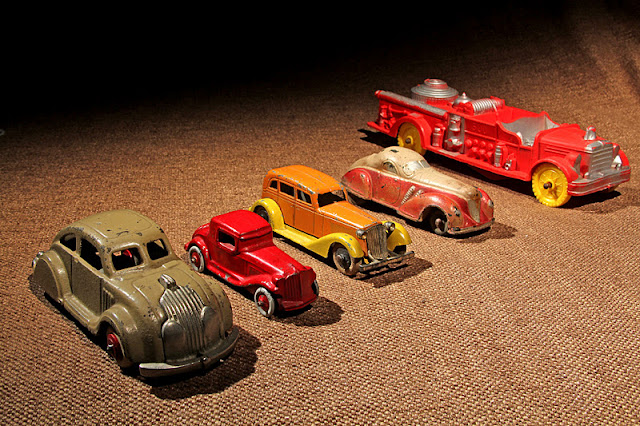Sunday, January 22, 2012
Vintage Rubber Toy Vehicles
The term "vintage" has become to be a general "buzzword" or term for old. An antique is something that is at least 100 years old. When I started to buy and sell on E-Bay, I kept coming across the term vintage. It was an easy way of being ambivalent about the description of a toy. These wonderful toys that I'm talking about today, are "youngsters" on the relative scale of old, but I call them "vintage" with a positive note.
If you've been reading this blog, you'll note that I initially focused on only 3-6 companies. They are Hubley, Wyandotte,Tootsietoy,and a little of Jane Francis, Manoil, and Barclay. These have been enough to learn about in 1 year, and I haven't even touched the surface, as the expression goes. Since I only buy within my budgetary limits, I can only buy, sell and write about those.
I was looking at what other toys were within my budget, and which could be resold either for a small profit, or to not be sold for too much of a loss. As a well-experienced buyer/seller of toys once told me at a local flea market: you're not going to get rich selling old toys! Anyway, I kept seeing rubber toys on E-Bay, and thought: "hey, they're rubber toys, do I really want to buy and sell them?"
I dove head first into buying about 8-10 rubber toys, and my intuition was correct. These toys that I am presenting today range in age form 50-75 years, and they're in very good shape for their age. Also, they're beautiful in design, colour, and detail. Also, as a photographer, they're wonderful "challenges" to make them come back to life with lighting.
The toys that I'm presenting today are the Sun Rubber Company, Arcor, and the Auburn Rubber Corp.
I've just added this brief part about the histories of the companies:
When you read any history about toys, you can't help but read about true American history, and since I buy and sell almost exclusively American toys, you begin to realize how the 2 - toy companies (toys) and American history are linked so close together.
Since I'm only writing 1 instalment on rubber toys, I am writing only a brief few paragraphs about the industry. But what occurred simultaneously in the real world history,cannot be overlooked, nor forgotten.
The rubber toy industry about 1935, when the U.S.A. was coming out of the Great Depression. There were many people who had lost their jobs and also lots of people who moved from the countryside to urban (city) areas of the country. In harmony with theses events, some toy companies such as the ones that mention below (Sun Rubber and Auburn) decided to expand their production by producing rubber toys.Both Auburn and Sun had already produced "play toys" for children. These included rubber small figurines such as soldiers, small dolls,and even small animals. Interesting, both companies were producers of rubber products (I'll find this information at another time), so getting into an expansion of their factories was not as hard as one would think. They had the materials from the far east, and a skilled workforce that was already familiar with the rubber process.
As America came out of the Great Depression, real car production started to improve.Also, many very interesting cars started to be made. America also was expanding,more roads were being built, and more people started to actually see many types of cars on the road. So the natural evolution to toy car production became a big hit.
Unfortunately, WWII (World War II) came upon the world, and toy production was stopped for the war effort. Companies produced such diverse items as gas masks or special airplane rubber aviation fuel containers (bladders) that were bullet resistant!
After the war, toy production returned to meet the demand of children. Unfortunately the history of the world and America moved on, as well as did toys. Foreign-produced toys were imported and plastic research was expanded to produce new raw variations to be used in toys and other products. Some companies never returned to production after WWII, and the Sun Rubber Company and the Auburn Rubber Company managed to stay in the toy production business until the early 1960's. I also happened to discover that the Auburn Rubber Company also used the name Arcor in producing rubber toys.

Left to Right:
A green Auburn, A Barclay slush toy, and a Sun Rubber sedan.
A Sun Rubber Sedan
This toy is a hard-rubber toy.
The Sun rubber toys are all black and are painted over with paint
A Beige and red Sun Rubber Coupe

A Yellow and Green Sun Rubber Coupe
A Sun Rubber Bus
A Soft-Rubber Auburn Fire Truck
These Auburns are soft-rubber, are newer (1950's), and are solid in colour.
Any minor paint (e.g. silver) is airbrushed on. What's interesting to note is that the paint job is purposely "crude" and not exact. There is spillage and overpainting all over!
The truck above is the largest item in this instalment today.
It measures 7 1/2" (L) x 2 1/2" (W) x 2 1/8" (H).
In metric that's 19 cm (L) x 6.5 cm (W) x 5.2 cm (H).
A Nice Auburn Truck
Auburn hard-Rubber Sedan
An Arcor Convertible
What's interesting to me is that how a rubber mould can capture the fine detail.
Also, as I mentioned before these toys certainly have stood the test of time and are in quite good shape considering they range in age from 50- 75 years "young".
If you've never been to Blogger, you can click on any image to enlarge it.
Doing do , will present the fine detail even better than the large size presented here.
So thanks for dropping by, and have a great morning,
afternoon or evening, and a restful day also.























































